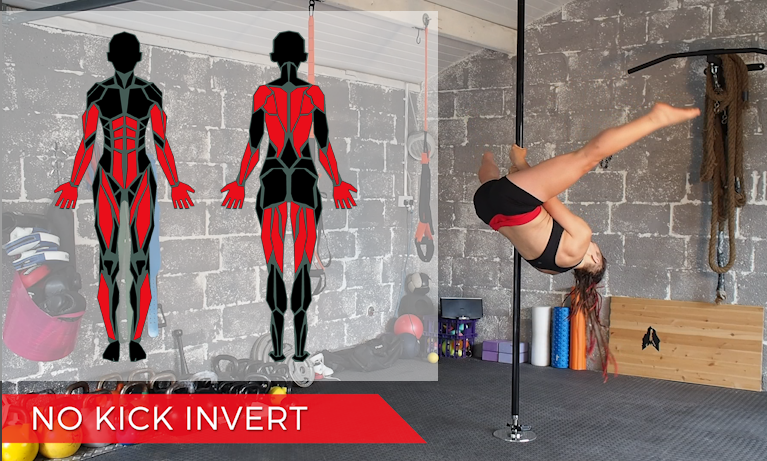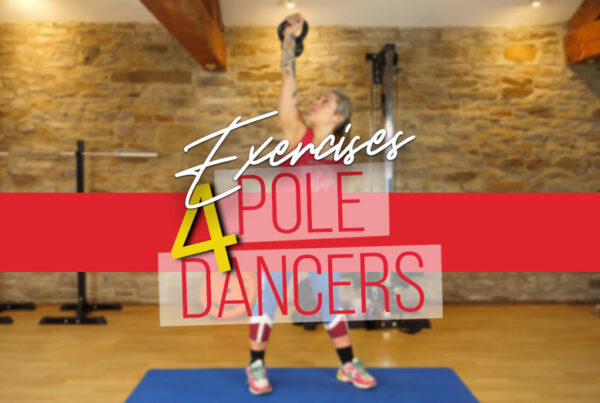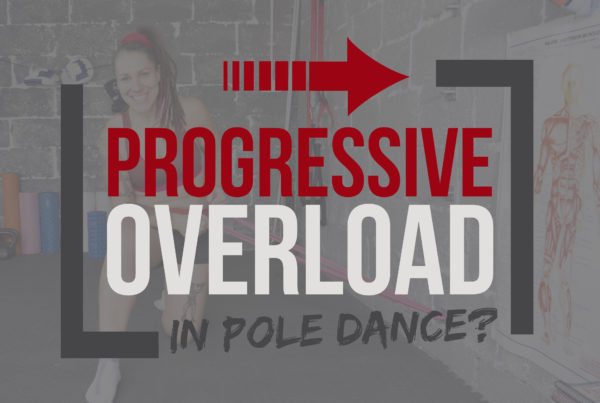Ahh, the good old invert. For beginner polers, it’s usually the first pole trick that can elicit actual gasps and firework-display-worthy “oooos” from non-pole friends.
And successfully nailing your invert is a bit like unlocking ‘mirror mode’ in Mario Kart. You know, the one that lets you play all the cups in reverse? By which, I mean that it immediately opens up a whole new kingdom of pole moves to add to your repertoire (and Instagram, obviously).
It started with a kick
For many of us, that first invert, as glorious as it may have been, was achieved with a little help from momentum.
Now, be honest. Who is STILL using a little kick or swing to get into their inverts? Lots and lots of polers, that’s who!
Personally, I wasn’t allowed to kick into my inverts. My pole instructor would only allow us to go upside down if we could do it without momentum. And although it may have been the most frustrating months of my life, I’m sooo glad I learnt it that way now.
Kicking up can be a hard habit to break. I understand why people do it and I understand why a lot of instructors teach it that way, but the ultimate goal should always be to be able to perform the move without the help of a kick.
Not only is it safer and more controlled, but it looks a whole lot prettier and stronger, too.
I know the struggle. When I was banging my head against the brick wall that is learning to invert without a kick, I binge-watched tutorial after tutorial, trying to uncover some hidden tip or trick that I must have been missing.
Almost there, almost there… cue monkey foot scrabbling for contact with the pole. Urgh.
Eventually, I discovered what the secret to a no kick invert was. And it was nothing to do with technique. The technique is actually quite simple once you have this one secret ingredient.
The secret? It’s strength. Pure and simple.
No tutorial can teach you strength, it must be earned—and that means putting in some serious training time to build strength in the muscle groups that need to be strong to get you upside down without a kick.
It also means training those muscle groups in a way that reinforces the correct movement pattern for a safe, controlled invert. Knowing which muscles to engage, and repeating that movement pattern until it becomes second nature.
And whilst we’re on the subject of doing things properly, it also means training in a way that isn’t going to create muscle imbalances or inefficient movement patterns that will impact your performance and injury-risk longer term. And, yes, part of that means training your dork side, too!
The anatomy of a pole invert
The video below highlights all the primary muscles we use to create a momentum-less invert / chopper (or ‘V straddle / ‘Open-V’, whatever name it goes by at your studio).
Spoiler: there’s a lot more going on than you think!
As you can see, there is a lot of upper body pulling power that is required for an invert and this is where many people lack the strength and correct engagement through the shoulders and arms.
But if you are able to hold your bodyweight off the pole easily in the invert position and do multiple leg tucks, with proper upper back engagement (i.e. board chest to avoid overly rounding the shoulders or upper back forward), it may instead be the combination of that correct shoulder / back engagement with the core and hip flexor strength required that is letting you down and preventing you from nailing that final, frustratingly elusive tuck that will get your hips to the pole in a controlled way.
I’ve included three of my favourite invert exercises below that you can start today to help you unlock your no-kick invert faster.
Bring on the next pole level… Ching, ching, ching!
Pole achievement: unlocked!
No-kick invert exercise 1: Floor invert tucks
Keep both shoulders flat on the floor for this one – watch out for the shoulders lifting as you tuck! I’d recommend keeping your hands on your lower tummy, too, so you can feel what’s going on there. You want to maintain that ‘belly button to spine’ squeeze – if your tummy starts to dome out at some point in the movement, it’s a sign that you may be losing that all important deep abdominal engagement.
This exercise may look simple, but perfect execution on this one is a crucial foundation for inverting without a kick.
To start, try 8 to 10 reps, 3 times through. Rest for 20-30 seconds in between sets.
No-kick invert exercise 2: Deadbug with resisted hip flexion
Yup, it’s another core exercise! Did I mention how important core strength is for the no-kick invert? 😉
This exercise has the added bonus of really challenging our hip flexors – another key area for the invert!
For this one, I’d usually start clients with 8 slow, controlled reps, pausing at the end point for a few seconds on each side, resting for 20-30 seconds in between sets. FYI – this is one of those exercises that is a lot more challenging than it looks! Enjoy!
No-kick invert exercse 3: Horizontal rows
Horizontal pulling strength is crucial if you want to take the kick out of your invert. It is strength in this pulling motion (coming primarily from the muscles in the mid-upper back) that will hold you in place as you lift your feet off the ground and allow you to control your body positioning as you tip backwards. One of my favourites for invert-specific strength training is the bent row with a pause as it incorporates both the pulling motion and the isometric hold that is so important for the invert.
Start with 3 sets of 10 repetitions, resting in between as you need. Focus on form – keep your shoulders back! 🙂
Want a full ‘done for you’ 6-week training program focused on one goal: getting you that no kick invert? Look no further! You can download my No Kick Invert Workbook and get training for your invert today! << This workbook contains all the nerdy knowledge and all the exercises and progressions you need to nail your No Kick Invert! Let’s get it!
Good luck with your invert mission! Please let me know how you get on – I’d love to see vids/pics of your hard work. Tag me on social media (@ptthepole on Instagram and @thepolept on Facebook) so we I can see! As always—feel free to ask if you have any questions at all!
Wanna know how to programme your training to get hella strong for pole inverts and beyond? I think you’ll love my book, Strength and Conditioning for Pole! It provides a nerdy, sports science based training framework that takes all the guess work out of getting strong for pole, so you can build your own training programme and start turning your pole daydreams into reality! 💪









I’ve signed up for a 12 session general fitness bootcamp in January and am filling in a PAR Q. Under the section “what are your goals” I want to explain which muscles I need to target in order to improve my chances of achieving a “no kick up” invert. Which particular Ab muscles do the 3 exercises above focus on please? (Only been poling since January!)
Hi Carolynn! Bootcamp sounds awesome. If you explain that you want to generally build a strong core (all core training will help you build a good foundation for this move), with a focus on lower ab strength, pulling strength and grip strength, those three things should help you get your no kick invert. If you mention ‘hanging leg raises’, this is a common gym movement that is kinda similar to an invert. It’s where you hang from a bar and lift the legs (either straight or tucked). It might help the people running the bootcamp understand the core strength that is required from the movement. Hope you have fun! Neo x
Thanks Neo, I’ll tell the PT about Hip Lifts, Hollowbody Holds, Seated Pike Lifts and Hanging Leg raises and what you’ve said in your reply above … that’s helpful thanks 🙂 xx
Hello,
I was wondering if you had any advice for my invert V’s. I’ve been training for a while now, but every time I do an invert V I get a strain that goes through my lower back. When I land and breathe out I can feel it (it’s like a sharp ache). I believe I’ve been using the right muscles and techniques. But I’m not sure what I’m missing. Have you any advice for this?
Hi Jess. Thanks for your message. The best thing I can suggest is to go see a physio as they will be able to do a hands-on investigation and will be able to explore if you maybe have some tight muscles that might be overworking and/or other muscles not activating, which might be causing the problem. It’s hard to say whether it’s a technique issue without seeing your form. It could potentially be from over extension in the lower back when you are lifting up into / coming out of your invert that might be corrected by something as simple as some extra core training and also making sure you tuck knees to chest before tipping back into your V (and reverse it in the same way) – BUUT that is just an example and a wild guess! Sorry I can’t be more specific, but as I say, the only way to really get to the bottom of it is get a hands-on consultation with a physio! ???? Hope you get some answers and please let me know how you get on with it! Neo x
Wow! I’ll try to do these and see if I finally get to invert (I haven’t even tried to “kick”-invert). It seems to me that my hips just won’t go up (too havy bottom, maybe).. thanks for the tutorials!!
Thanks, Marina. Everyone feels like their butt is too heavy at first, but I promise it isn’t and you will get there! You do best avoiding the ‘kick’ and building strength for the lift instead. Have fun – enjoy the process and keep me posted how you get on! Neo x
Thanks! I’m going to try these exercises! I had just spent an hour and a half trying to get the kick invert with no success. Firstly I’m too scared to lean back, secondly I have no core strength. 🙁
Aw Aly. It’s a combination of technique and strength, for sure. You will get there. ????
Hi Neo, when I try to hold myself on the pole, I find my body sinks (if that makes sense) so that even if I have core strength I am just not high enough cause I am hanging by my arms. What can I do to address this issue? I often feel strain in my neck just trying to do anything. Thanks for the info on training for invert. Love the way you explain every thing.
Hi Izzy! Thank you for your kind comments. Ah, there is so much more going on with the invert than just core strength. Working on your general upper body strength and shoulder engagement will really help, too – as well as conditioning the technique and correct muscle engagement from the floor with exercises like these ones (Floor based leg hang: https://youtu.be/tgH4FMbKKh4 and Floor based half chopper: https://youtu.be/H9tRfwv1mnI), before you start to do it up the pole. If you feel strain in your neck, it could be something amiss in your technique – or perhaps the wrong muscles trying to take all the effort. If you can get in to a physio for a hands-on assessment, too, they should be able to help pinpoint any overactive muscle groups and give you some soft tissue release that might help. Keep me posted how you get on! ????